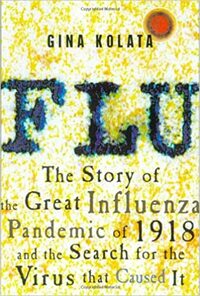You need to sign in or sign up before continuing.
Take a photo of a barcode or cover
92 reviews for:
Flu: The Story Of The Great Influenza Pandemic Of 1918 And The Search For The Virus That Caused It
Gina Kolata
92 reviews for:
Flu: The Story Of The Great Influenza Pandemic Of 1918 And The Search For The Virus That Caused It
Gina Kolata
Funny how something so "simple" as the flu is such a tough nut to crack. Interesting to me that this book came out in 1999 not too long after the Asian bird flu panic, and yet it's still relevant now, given the whole H1N1 panic in the past year.
This book is not so much about the what the flu pandemic of 1918 was like, and more about the search for the exact virus that caused it. There's fascinating information about the science, other pandemics, and all the people involved in searching for the virus. Definitely an eye opening read while we live through a new pandemic.
informative
slow-paced
A lot of information about the Flu Pandemic of 1918. It was crazy how I was reading a book about a pandemic all the while wearing a mask and using hand sanitizer in the middle of a pandemic of a different virus. It won't be a big explosion of nuclear weapons or catastrophe from outer space that destroys us, no, it will be some small thing that invades people's bodies that will do the most damage. Just like The War of the Worlds story. It's a scary time to be alive.
This book thought the pandemic of 1918 was the most destructive to our population. Well, the universe said "hold my beer". And along came COVID-19. If we don't learn from these events what will happen then?
This book thought the pandemic of 1918 was the most destructive to our population. Well, the universe said "hold my beer". And along came COVID-19. If we don't learn from these events what will happen then?
I thought this was a fascinating look at a subject that I didn't know enough about. The chapters each had a theme and the writing was clear with technical and scientific situations explained well.
I had two issues with the book: (1) It could have used tighter editing as some chapters had a lot of repetition, specifically with phrases. (2) One of the chapters described a scientist who organized an expedition as having "doe eyes" and "undeniably attractive to some of the men on her team". The description really took me out of the narrative and I felt it didn't not fit the serious theme of the book. It made it seem as though the author had a bias.
Overall, this is a great overview of a critical event and search for answers, with clear explanations that neither talked down nor contained an overload of information. Two quibbles aside, I recommend Flu if you wish to learn more about the pandemic of 1918.
I had two issues with the book: (1) It could have used tighter editing as some chapters had a lot of repetition, specifically with phrases. (2) One of the chapters described a scientist who organized an expedition as having "doe eyes" and "undeniably attractive to some of the men on her team". The description really took me out of the narrative and I felt it didn't not fit the serious theme of the book. It made it seem as though the author had a bias.
Overall, this is a great overview of a critical event and search for answers, with clear explanations that neither talked down nor contained an overload of information. Two quibbles aside, I recommend Flu if you wish to learn more about the pandemic of 1918.
I used to work for a company that tracked influenza, and the 1918 pandemic was a regular topic of lunchtime conversation. Read this as soon as it came out, and loved it, but could see where the uninvested reader might lose heart. Reviews both the epidemiology and some of the public-health reasons it was able to spread so fast.
It's going to happen again, so it's good information to have under your belt.
It's going to happen again, so it's good information to have under your belt.
I found this really quite interesting, as the most I had ever really come across the 1918 flu previously was part of a documentary.
The author describes the science fairly well, without getting too bogged down in it (though since I already knew some of the information, it could make less sense to someone else) and had a very easy to read writing style. Some parts of it seemed a bit America-centric, but that's only to be expected and didn't really affect it. I enjoyed reading about the various assorted cast of people who'd become involved in the quest for knowledge of the flu, whom the author introduced in an entertaining manner.
The author describes the science fairly well, without getting too bogged down in it (though since I already knew some of the information, it could make less sense to someone else) and had a very easy to read writing style. Some parts of it seemed a bit America-centric, but that's only to be expected and didn't really affect it. I enjoyed reading about the various assorted cast of people who'd become involved in the quest for knowledge of the flu, whom the author introduced in an entertaining manner.
informative
sad
medium-paced


